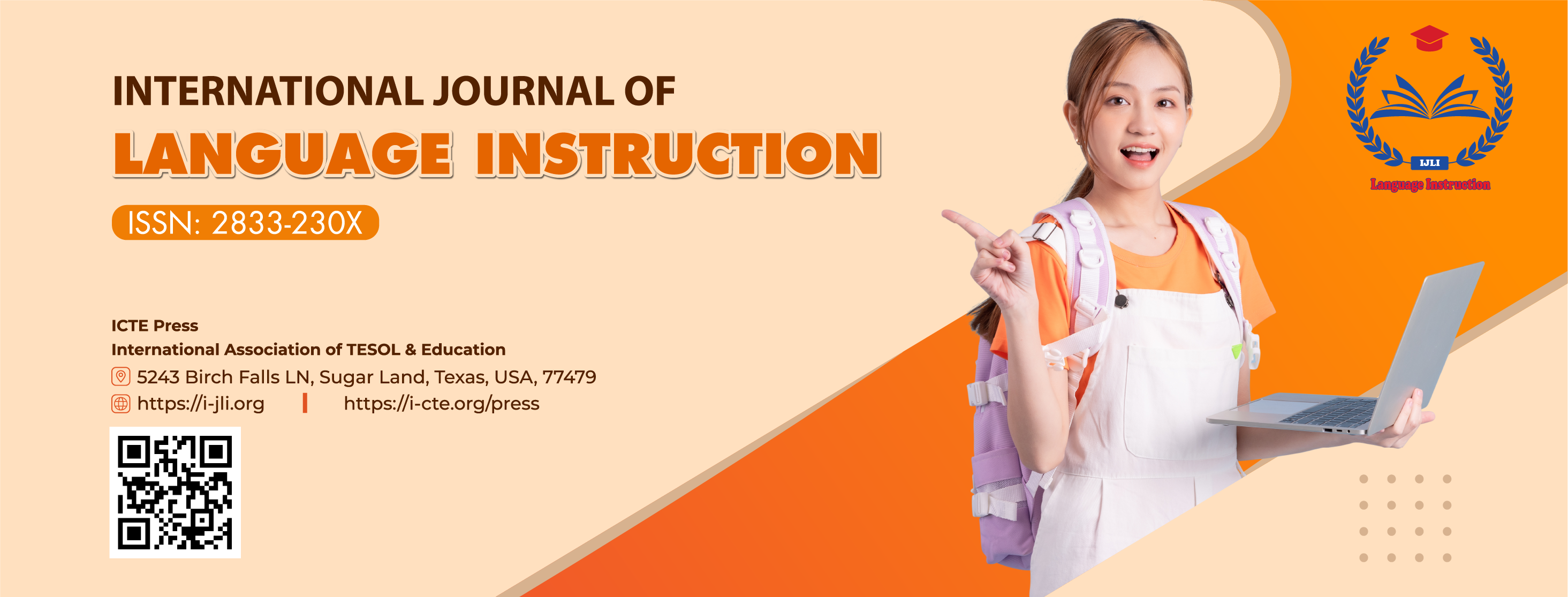From Words to Wonders: EFL Students' Perceptions of Digital Storytelling for Language Learning
DOI:
https://doi.org/10.54855/ijli.24344Keywords:
Digital Storytelling, Multimedia, EFL, Teaching, LearningAbstract
This study investigated the use of digital storytelling (DST) in university-level foreign language classes in Vietnam, focusing on students' perspectives. While the term "digital storytelling" may not be widely recognized, it has been adopted by educators, students, and others worldwide as a way to create short films by integrating multimedia elements. The research problem addressed in this study was to extensively examine students' views on incorporating DST projects into their foreign language courses to enhance students' confidence, interaction, and motivation. Data was gathered through various methods, including questionnaires, interviews, observations, student-made videos, and online comments, to describe and interpret the case from the participants' (83 EFL students) perspective. The results indicate that DST positively impacted students' language confidence, critical engagement, motivation, and interpersonal relationships. Students recognized the advantages of DST, such as enhancing language skills and boosting engagement, but also acknowledged the need for more time, resources, and a clear educational strategy to fully integrate DST into the language learning curriculum.
References
Ahmad W. I. W. & Yamat H. (2020). Students’ perception on learning English language through conventional and digital storytelling, International Journal of AcademicResearch in Business and Social Sciences, 10(2), 484–504. DOI: https://doi.org/10.6007/IJARBSS/v10-i2/6945
Alexander B. (2011). The new digital storytelling: Creating narratives with new media. ABCCLIO. Greenwood Publishing Group.
Arroba, J., & Acosta, H. (2021). Authentic digital storytelling as an alternative teaching strategy to develop speaking skills in EFL classes. LEARN Journal: Language Education and Acquisition Research Network, 14(1), 317–343.
Miller, A. & Mills, B. (2019). 'If They Don't Care, I Don't Care': Millennial and Generation Z Students and the Impact of Faculty Caring.Journal of the Scholarship of Teaching and Learning,19(4), 78-89.
Balaman F. (2016). The effect of digital storytelling technique on the attitudes of students toward teaching technologies, Pegem Journal of Education and Instruction, 6(2), 147-168.
Brown J., Bryan J., & Brown T. (2006). Twenty- first century literacy and technology in K–8 classrooms. Innovate, 1(3), 2005. Retrieved March 20, 2006, from http://www.innovateonline.info/index. php?view=article&id=17
Bui, T. X. T., Ha, Y. N., Nguyen, T. B. U, Nguyen, V. U. T, Ngo, T. C. T. (2021). A study on collaborative online learning among EFL students in Van Lang University (VLU). AsiaCall Online Journal, 12(3), 9-21. Retrieved from https://asiacall.info/acoj/index.php/journal/article/view/32
Castañeda, M. E. (2013). "I am proud that I did it and it's a piece of me": Digital storytelling in the Foreign language classroom. CALICO Journal, 30(1), 44–62.
Castañeda, M. E., & Çalışkan, H. (2019). The effect of digital storytelling on EFL students' speaking anxiety. The Turkish Online Journal of Educational Technology, 18(1), 44–56. Center for Digital Storytelling Website (2005). http://www.storycenter.org/history.html
Cohen, L., et al. (2004). A Guide to Teaching Practice (5th ed.). London: Routledge.
Creswell J. W., & Plano V. L. (2015). Clark, Karma Yöntem Araştırmaları: Tasarımı veYürütülmesi [Designing and conducting mixed methods research].
Dey I. (1993). Qualitative Data Analysis: A User Friendly Guide for Social Science. London: Routledge. DOI: http://dx.doi.org/10.4324/9780203412497
Chau, K. G. (2021). The Effect of ICT on Learners’ Speaking Skills Development. International Journal of TESOL & Education, 1(1), 22–29. Retrieved from https://i-jte.org/index.php/journal/article/view/4
Du, T. M., Nguyen, T. N., & Le, N. A. (2024). Improving first-year English-majored students' speaking skills through using digital storytelling. International Journal of Language Instruction, 3(2), 29–44. https://doi.org/10.54855/ijli.24323
Gregori-Signes C. (2008a). Practical uses of digital storytelling, CD_Publication.
Hafner, C. A., & Miller, L. (2011). Fostering learner autonomy in English for science: A collaborative digital video project in a technological learning environment. Language Learning & Technology, 15(3), 68–86.
Hwang W., Shadiev R., Hsu J., Huang Y., Hsu G. & Lin Y. (2014). Effects of storytelling to INTED2007 Proceedings. ISBN: 978-84-611-4517-1.
Jakes D. S., & Brennan J. (2007). Capturing stories, capturing lives: An introduction to digital story-telling, 2005. Retrieved May 2, 2007, from http://www. jakesonline.org/dstory_ice.pdf
Kajder S. (2006). Enter here: Personal narrative and digital storytelling. The English Journal, 93, 64-68. DOI: https://doi.org/10.2307/4128811
Kukul, V. (2024). Should I use digital storytelling in my future classroom? Why or why not? Investigating pre-service math teachers’ acceptance of digital storytelling. E-Learning and Digital Media, 21(1), 70-86. https://doi.org/10.1177/20427530231156173
Kuyvenhoven, J. (2009). In the presence of each other: A pedagogy of storytelling. University of Toronto Press.
Lambert, J. (2013). Digital storytelling: Capturing lives, creating community. Routledge.
Lambert, J. (2021). Overcoming challenges in digital storytelling for language learning. Journal of Educational Media, 16(4), 245–259.
Le H. (2020). Using Digital Storytelling in Vietnam, Retrieved March 14, 2022, from https://www.academia.edu/35951148/using_digital_story_telling_in_Vietnam_docx
Mahmawati, D., & Mubayyinah, S. (2024). Storytelling method to improve the students’ speaking skill for the class x students of Ma Miftahul Midad Lumajang in academic year of 2023/2024. Mastery: Master of English Language Journal, 2(1), 149–163. Retrieved from https://ejournal.stitmiftahulmidad.ac.id/index.php/mastery/article/view/113
Marta T. (2024). Digital Storytelling: Changing Learners’ Attitudes and Self-efficacy Beliefs. Applied Linguistics, Volume 45, Issue 1, Pages 65–87. https://doi.org/10.1093/applin/amad002
Matthews-Denatale G. (2008). Digital Storytelling: Tips and Resources. Boston, MA: Simmons College.
Maylia, A. (2021). The Teaching of Speaking Using Storytelling (Doctoral dissertation, Universitas Islam Kalimantan MAB).
Microsoft (2008). Microsoft Photo Story 3 for Windows, 2007. Retrieved July 20, 2008, from http://www.microsoft.com/photostory
Mirza, H. S. (2020). Improving university students’ English proficiency with digital storytelling. International Online Journal of Education and Teaching (IOJET), 7(1), 84-94. http://iojet.org/index.php/IOJET/article/view/668
Morra, S. (2013). 8 Steps To Great Digital Storytelling, Retrieved December 08, 2014. From https://samanthamorra.com/2013/06/05/edudemic-article-on-digital-storytelling/
Mullen R., & Wedwick L. (2008). Avoiding the digital abyss: Getting started in the classroom with YouTube, digital stories, and blogs, The Clearing House: A Journal of Educational Strategies, Issues and Ideas, 82(2), 66-69.
Murad, T., Assadi, J., & Badarni, H. (2023). Digital storytelling and EFL speaking skill improvement. Journal of Language Teaching and Research, 14(4), 1189-1198. DOI: https://doi.org/10.17507/jltr.1405.06
Nair, V., & Yunus, M. (2021). A systematic review of digital storytelling in improving speaking skills. Sustainability, 13(7), 9829. DOI: https://doi.org/10.3390/su13179829
Nair, V., & Yunus, M. (2022). Using digital storytelling to improve pupil’s speaking skills in the age of COVID-19. Sustainability, 14(15), 9215. DOI: https://doi.org/10.3390/su14159215
Niemi, H., & Multisilta, J. (2016). Digital storytelling promoting twenty-first century skills and student engagement. Technology, Pedagogy and Education, 25(4), 451–468.
Ohler J. (2008). Digital storytelling in the classroom: New media pathways to literacy, learning, Thousand Oaks, CA: Corwin Press.
Ohler J. (2013). Digital storytelling in the classroom: New media pathways to literacy, learning, and creativity, Corwin Press.
Ohler J. (2021). Digital literacy and storytelling in education. Journal of Digital Learning, 14(2), 110–125.Ohler J. (2022). The future of digital storytelling: AR and VR integration. Journal of Emerging Technologies, 5(3), 88–100.
Pardo B. S. (2014). Digital Storytelling: A case study of the creation, and narration of a story by EFL Learners, Digital Education Review, (26), 74-84.
Partnership for 21st Century Skill (2004). Proceedings of Society for Information Technology and Teacher Education International Conference, pp. 709-716. Chesapeake, VA: AACE.
Rance-Roney J. (2008). Digital storytelling for language and culture learning. Essential Teacher, 5, 1, pp. 29–31.
Robin B. (2005). Educational uses of digital storytelling, Main directory for the educational uses of digital storytelling, Instructional technology Program, University of Huston. Retrieved from http://www.coe.uh.edu/digital-storytelling/introductiontroduction.htm
Robin, B. (2006). The educational uses of digital storytelling. Technology and Teacher Education Annual, 1, pp.709.
Robin B. (2008). Digital storytelling: A powerful technology tool for the 21st century classroom, Theory into Practice, 47(3), pp.220 228. DOI:0.1080/00405840802153916
Robin B. R. (2016). The power of digital storytelling to support teaching and learning. Digital Education Review, 30, pp. 17-29.
Robin, B. R., & McNeil, S. G. (2012). What educators should know about teaching digital storytelling. Digital Education Review, (22), 37-51.
Robin, B. (2020). Digital storytelling in education: An overview. Educational Technology Research and Development, 68(3), 205–220.
Roy, A. (2024). Impact of Digital Storytelling on Motivation in Middle School English Classrooms. International Journal of Computer-Assisted Language Learning and Teaching (IJCALLT), 14(1), 1-20. http://doi.org/10.4018/IJCALLT.353434
Russell V. J. et al. (2005). Student motivation and Engagement, Schooling Issues Digest, Australian Government, Department of Education, Science and Training.
Smeda, N., Dakich, E., & Sharda, N. (2014). The effectiveness of digital storytelling in the classrooms: a comprehensive study. Smart Learning Environments, 1(1), 1–21.
Schmidt C. (2004). The analysis of semi structured interviews. A companion to qualitative research, 2004, London: Sage. The Digital Storytelling Association (10/5/2014). The center for digital storytelling, 2011; Available from: http://electronicportfolios.com/digistory/
Shahid, M., & Khan, M. R. (2022). Use of Digital Storytelling in Classrooms and Beyond. Journal of Educational Technology Systems, 51(1), 63–77. https://doi.org/10.1177/00472395221112599.
Shinas, V. H., & Wen, H. (2022). Preparing teacher candidates toimplement digital storytelling. Computers and Education Open, 3, https://doi.org/10.1016/j.caeo.2022.100079
Van Gils (2005). Potential applications of digital storytelling in education, In the proceedings of 3rd Twente Student Conference on IT, Enschede June.
Van, L. K., Dang, T. A., Pham, D. B. T, Vo, T. T. N., Pham, V. P. H. (2021). The effectiveness of using technology in learning English. AsiaCall Online Journal, 12(2), 24-40. Retrieved from https://asiacall.info/acoj/index.php/journal/article/view/26
Vice, T. A., Pittman, R. T., & Warnick, E. M. (2023). Blocked or unlocked: Recognizing the benefits and challenges of digital literacy storytelling projects. Journal of Education, 203(2). https://doi.org/10.1177/00220574231162590.
Wan G., et al.(2008). Creating constructivist Learning environment for Japanese EFL Students: A digital story program. The Asian EFL Journal Quarterly, 10 (2), pp. 31-50.
Wawro L. (2012). Digital storytelling: More than the sum of its parts, Children & Libraries: The Journal for the Association for Library Service to Children, 10, 1, pp. 50-52.
Wilden S. (2017). Mobile Learning. Oxford: Oxford University Press.
Windy Astuti, M., & Chakim, N. (2023). The Use of Digital Storytelling to Improve Students’ Speaking Ability in Secondary EFL Classroom. JELITA, 4(2), 190-202.https://doi.org/10.56185/jelita.v4i2.347
Yang, Y. T. C., Chen, Y. C., & Hung, H. T. (2020). Digital Storytelling as an Interdisciplinary Project to Improve Students’ English Speaking and Creative Thinking. Computer Assisted Language Learning,2020,123.https://doi.org/10.1080/09588221.2020.1750431
Yang, H., & Wu, X. (2021). The impact of digital storytelling on language learning. Journal of Educational Technology & Society, 24(2), 27–39.
YouTube (2022). https://www.youtube.com/results?search_query=digital+story
Downloads
Published
Issue
Section
License
Copyright (c) 2024 Phan Thi Anh Nga, Le Huong Hoa, Phan Gia Anh Vu

This work is licensed under a Creative Commons Attribution 4.0 International License.
The copyright of all articles published in the International Journal of Language Instruction (ijli) remains with the Authors, i.e. Authors retain full ownership of their article. Permitted third-party reuse of the open access articles is defined by the applicable Creative Commons (CC) end-user license which is accepted by the Authors upon submission of their paper. All articles in the ijli are published under the CC BY-NC 4.0 license, meaning that end users can freely share an article (i.e. copy and redistribute the material in any medium or format) and adapt it (i.e. remix, transform and build upon the material) on the condition that proper attribution is given (i.e. appropriate credit, a link to the applicable license and an indication if any changes were made; all in such a way that does not suggest that the licensor endorses the user or the use) and the material is only used for non-commercial purposes.
Authors are able to enter into separate, additional contractual arrangements for the non-exclusive distribution of the journal's published version of the work (e.g., post it to an institutional repository, in a journal or publish it in a book), with an acknowledgment of its initial publication in this journal.











